Page 1 2
Go  | New  | Find  | Notify  | Tools  | Reply  |  |
Member |
I very carefully loaded 168 and 175 grain Sierra MatchKings for my 308 semi-auto. All shots were shot from prone at 100 yards with one minute pauses between shots. I shot as carefully and consistently as I am capable yet my targets don't look like I expected. Using two targets, the order of fire was as follows. 1 was the lowest charge increasing in powder weight sequentially to 8. The three center shots were just sighter shots. Target 1 | Target 2 1-2 | 3-4 O | O 5-6 | 7-8 Here are the 168s: 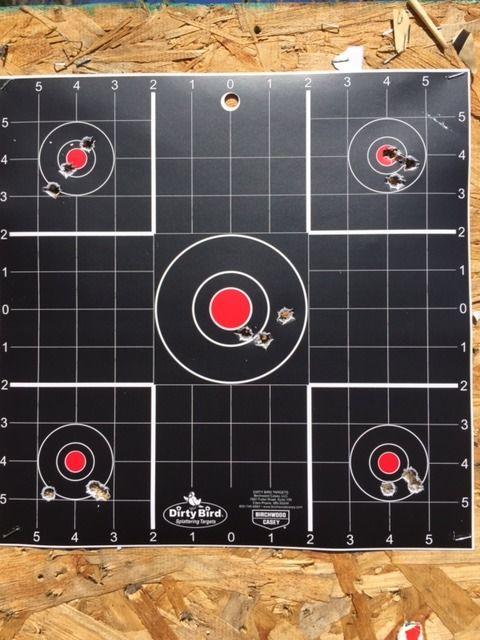 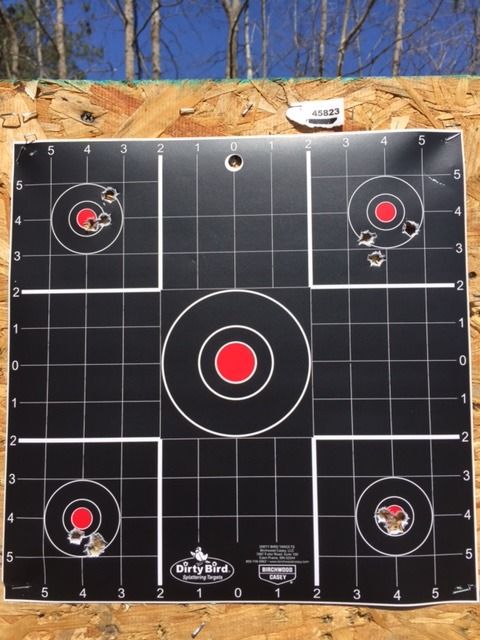 Here at the 175s 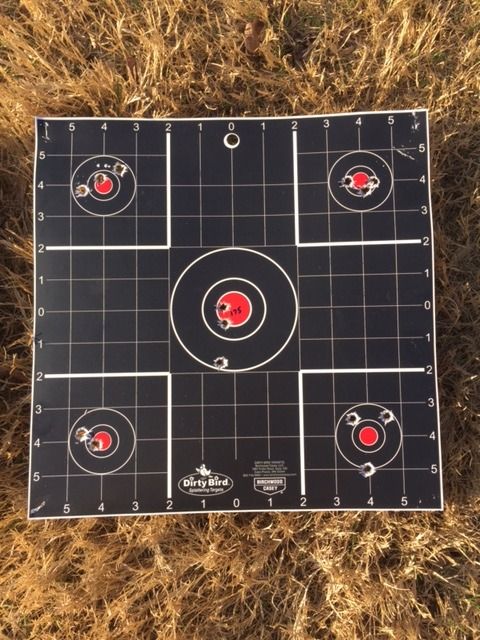 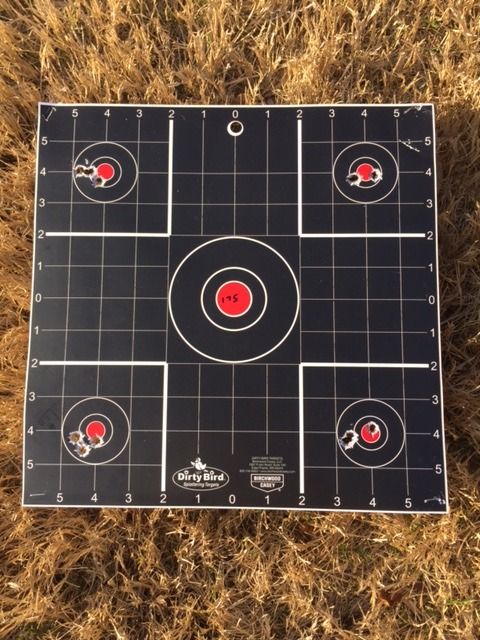 I think the book answer is group #6 is the one to pick for the 168s as it is bracketed by other 5:30 groups. For the 175s there is no clear answer. Maybe group 7 or 8 as they are similarly located? Thanks in advance for your help. Henryrifle | ||
|
| Member |
Were you shooting single load or from a magazine? What re the powder load increments? Are all groups 3 rounds? Should really do 5. Barrel length? I would have like to see the next one after #8 for the 168gr. | |||
|
Member |
All rounds were loaded single load by hand. The magazine was inserted but not used. Powder Load Increments (Did not load or shoot Red loads) Powder was Varget 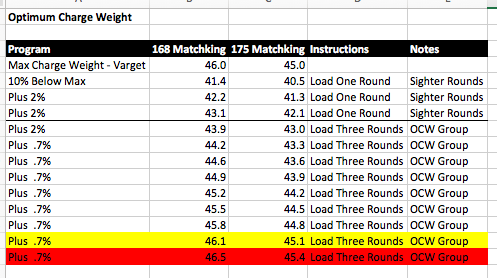 All groups are three rounds including group 5 of the 175s. There are 2 bullets on the same upper hole. Barrel is 20" Polygonal cut 1/10 twist LaRue. I would like to see the next 168g set too but it is .4 grains over the maximum value. There were no significant pressure signs on any cartridges. Maybe some slightly flattened primers but no swipes. Thanks, Henryrifle | |||
|
| Member |
I don't reload, but I do watch the target results of those who do. Your target results look unusual to me. - How do your target results compare to factory FGMM? I may be thinking of someone else, but I believe you compared factory ammo quite awhile ago. - In all honesty, your variation from one group to the next could be from inconsistent shooting technique, not load differences. | |||
|
Member |
Trying to make this a little easier: First this is the 168g SMK targets showing the shot order: 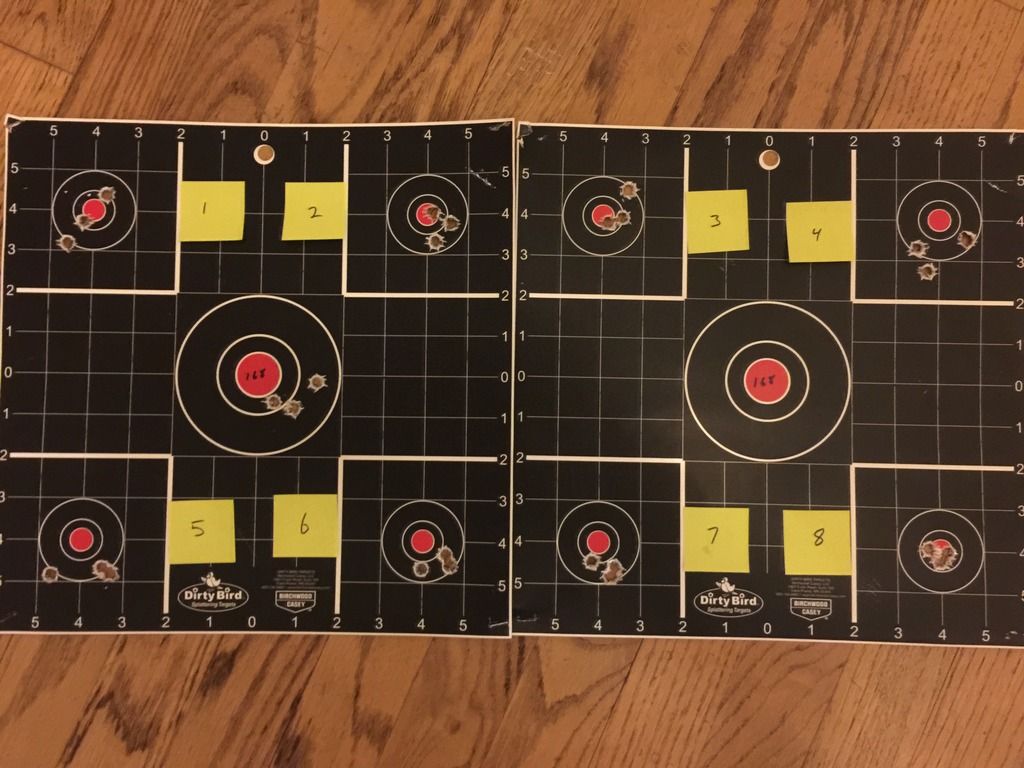 If the goal is to select the a load that yields the greatest POI stability then, I think that target 7 is in the middle of a relatively stable POI grouping. That maps back to 45.8 grains of Varget. Next is the 175g SMK targets showing the shot order:  Using the same methodology as above, Target 4, 43.9 grains of Varget, seems to be the load to start with. It is difficult to tell in this picture but there are three shots in both targets 4 and 5. In both cases there are two bullets in the left most holes of both groups. I think I will repeat the tests in full using 5-shot groups to see if the above is good data or not but first I will load what look to be the correct loads. Assuming for a moment that the above data is good for the purposes of discussion, is this similar to your experience with an OCW test? It is not the obvious indicator I was hoping for but it is my first time trying it. Thanks again, Henryrifle | |||
|
Member |
fritz-you could easily be right. Like I said, I tried as hard as I could but I am not claiming to be a great rifleman. I didn't think that there was a bad shot after each broke and I took my time and tried to check off the fundamentals prior to each shot, knowing how important each shot was if any good conclusions were to be drawn. Perhaps I failed. I have not shot much factory ammo in this rifle. It is relatively new with about 300 rounds through it at this time. There are several groups that are less than 1 MOA which indicates something more than luck but maybe not much more than that. Never having done this before it is still a good learning exercise. Thanks for looking! Henryrifle | |||
|
| Member |
On further analysis, I would run another series, this time 5 shots each between 45.2 and 46.0 of Varget for the 168. (45.2, .4, .6, .8, 46.0) Do this in a round robin fashion; shoot 1 round on each at a time on each of the appropriate target, then start over again with the next round, again on each of the targets. Do not shoot all rounds for one load, then the next and the next. You want to spread the fouling and the fatigue over all the targets. For the 175, group 6 really befuddles me, it's so out of whack with the rest of the groups. I would probably run that series again, dropping load 1 and adding a load after 8, at 45.5. Unless you're a glutton for punishment, I would do this on two different days or certainly take a long break (hour or more) between doing 168 and 175. Heck I would suggest you start with the 175s first. | |||
|
Member |
Thank you, NikonUser. That is a good plan to tease out some more detail about the performance of the loads between those endpoints. Today, especially, I identify with the part about the rest. My shoulder pocket is a little sore from yesterday! After shooting the OCW groups I shot several more shots on the 500m steel range. Not as a correction but to add some detail, all shots except the sighters were fired in round-robin sequence of one shot each: 1-2-3-4-5-6-7-8 followed by one more shot into: 1-2-3-4-5-6-7-8 and ending with a final round of 1-2-3-4-5-6-7-8. I left this detail out in previous posts as it is so integral/foundational to the OCW methodology I assumed it unnecessary to make that declaration. I am going to take the time to put all groups in OnTarget to see if there is anything else interesting to observe/learn. Graphics added - 168 on top of 175: 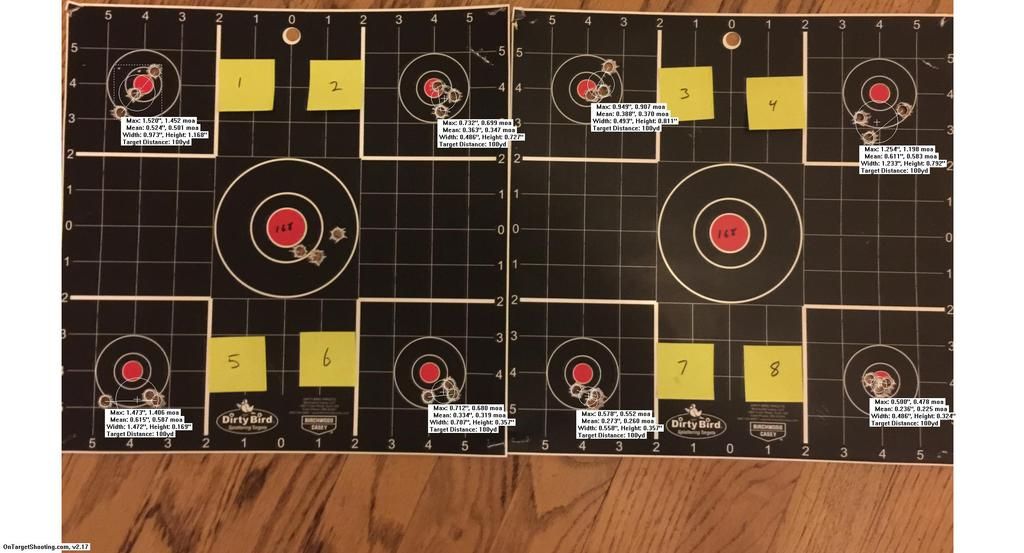 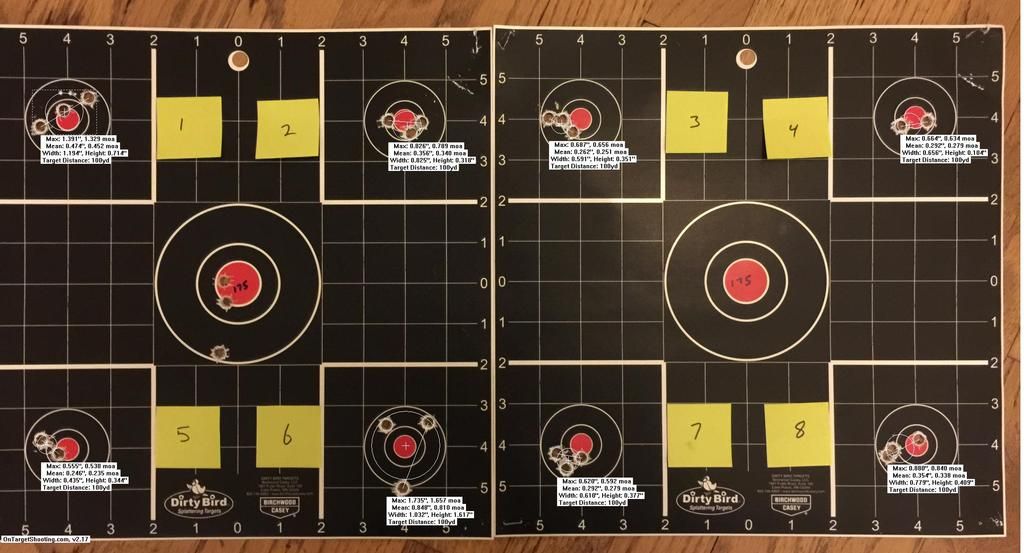 Thank you again, Henryrifle | |||
|
| Member |
I love the way we have to extract information piecemeal. :-) I know that round-robin in integral to the OCW regimen, but you would be surprised at how many people don't do it that way. I try to never assume things when it comes to shooting. Like never assume the rifle is empty. :-) Looking forward to the next series. And make sure it's 5-shot groups. | |||
|
Member |
I get it and I appreciate your help and advice. Thank you again, Henryrifle P.S. Reading through Dan Newberry's OCW site, he is kind (brave?) enough to publish some of his findings. Here are some interesting combinations: 168g projectile and 46g of Varget & 175g projectile and 45g of Varget. I understand that this is NOT how you use OCW tests but 46 grains Varget for 168g projectile is right between #7 & #8 of my test. Similarly, 45 grains of Varget with a 175g projectile is also just between #7 and #8 of my test. Both are respectable sub MOA groups with the 168 groupings being clearly better and in a closer POI. P.S.S. I have been enjoying reading through all of your reloading documentation. Have been reviewing it for months and months! Thanks for the investment you've made on that side of the forum as well. | |||
|
| Member |
If the round robin method of shooting works for you, then great, but I've seen it produce issues for others. The most common is not matching loads to targets, the next is changing wind conditions messing up groups. Sure, wind changes can mess with any shot and any group. But at least with each string occurring in a relative short time, we can note the conditions for each string, then eliminate those strings with really odd conditions. We can always come back another day. Yesterday was mainly a work day at the range for me, because winds were horrible. 10-15 mph from my 3-6 o'clock, gusting to 20-25 mph. I had two goals -- evaluate some 22lr loads out to 250 yards and confirm a 100 yard zero on a 6.5 creedmoor rifle. I threw out many of the 22lr results due to swirling winds. I was able to confirm the 6.5's zero, as vertical variation was no more than 1/4", but I had horizontal stringing of over 3/4" from the cross winds. I understand the concept of single loading a semi auto. Five to ten years ago I just couldn't seem to shoot consistent groups with ARs. I tried single loading -- it helped, but breaking position to load may still have been an issue for me. I tried loading 7+ rounds in a mag, throwing the first and last rounds of a mag onto another target. This seemed to help a bit more with the 5 rounds on my designated target. I don't worry about where I shoot within the magazine anymore. My groups are consistent from one part of the mag to the next. I must compete with full mags, almost empty mags, and everything in between. What's changed over the years? Me. I shoot better now. Sure, if I needed gnat's ass precision at 500+ yards and had boat loads of time between shots, I'd revisit single loading. But with at 100 yards with a rifle never meant to compete in F-Class competition, I don't see single loading and its potential for not rebuilding a good position between shots. Waiting one minute between shots to keep the rifle cool makes sense for one of my rifles -- a 1948 .270 Winchester Model 70, complete with a thin barrel that isn't free floated. This slow style of shooting isn't realistic for all my other rifles. If they can't handle 3-5 rounds in 30 to 60 seconds, then I don't need to own them. This is rate at which I shoot in competition; and it's about how I practice, evaluate ammo, and confirm elevation requirements at distance. I recommend revising your ammo development with strings of 5 rounds, shot with all five on one target, from the same mag. Then get up from the gun, load another mag, move around, relax, do whatever to keep yourself fresh. Then shoot another string of 5. Also, compare your load development against factory Federal GMM ammo -- it should be your baseline for accuracy. | |||
|
Member |
Good morning, fritz: You are a great asset to this forum and I find your posts to be informative and often containing valuable wisdom based on personal experience. I think of myself as a student of several activities for which I have a lot of interest, and, as such, there is almost always something for me to learn from your posts. It sounds like you have been diligently working on honing your skills as a long distance shooter for a while and I want to make sure that I don't write anything that might cause you to withhold some valuable knowledge or experience. That is not my intention. In this case, as you don't reload, maybe you are not fully comprehending the point of an OCW test. I don’t want to shoot single load either. I have had nightmare thoughts about dropping the ammo box on the way to the line with freshly loaded cartridges popping out like popcorn and causing the loss of hours of work as I would not know which cartridges are loaded with which load. If you saw me carry the box to the line, you'd get a good chuckle as I must have looked like I was carrying a box of precious and fragile treasures. I also don’t want to load them in the magazine because if one pops out or if I fumble while loading I would have a similar though smaller problem. It is also easier to single load when selecting specific cartridges from several different groups in the box. Shooting round-robin is not something I would normally choose to do, but that is part of the OCW methodology. I could modify the methodology but then no one familiar with this method is going to be able to help because it was not performed using the accepted/standard methodology. As you say, wind does not have a large effect on accuracy at 100 yards using 168 and 175 grain .308. Some horizontal dispersion is possible (about 1 MOA in 15-20 mph winds) or even likely but there was little to no wind during my testing above. I am also not interested in waiting a minute or any other structured interval between shots but I did want to perform the test with as much consistency as possible. Also, I realize that I am not good enough to wring the last .1 MOA out of my loads or my rifle. OCW, in fact, is not about that. It is about finding a good load that meets your needs that is very tolerant of real-world inconsistencies in temperature, seating depth, powder charge and etc. While the cartridges used in the tests above and those to follow were loaded on my single stage press, I am hoping to find a load that I can load progressively on my Dillon and crank out 500 in a few hours. So here’s the deal, You are about 10 years ahead of me in this game. I respect that and am not competing with you. That would just be silly. I can learn a lot from you but I can’t bridge the 10-year gap in knowledge/experience all at once. Whether you realize it or not, you have a tremendous amount of experience that helps you understand why you do what you do that I don’t possess. We are also on different trajectories as I do reload and reloading has its own learning curve that is, at least, equally as intricate as the shooting itself. Lastly, and if I haven’t sounded defensive enough already, this will be the tipping point for sure! Look at the targets above and consider the 16 groups that were created by shooting round-robin style with loads that I would not normally try. Of the 16 groups, 10 or 62% were sub MOA. If you just look at the 175 grain test, 6 out of 8 or 75% were sub MOA while 4 out of 8 or 50% of the 168s were sub-MOA. I am not particularly proud of those statistics and if graded on a school scale one is a failing grade while the other is a C, at best. I have shot better looking groups than those but this was the first test looking for the OCW load. Shooting sub MOA with hand loads means some things did go right. You can tell me that my technique is lacking and you will not get any pushback from me as I know that is true but as Jules said to Ringo, I’ll say to you: I’m trying fritz, I’m trying real hard… Henryrifle | |||
|
| Member |
Let me just add that round robin is critical to the OCW. When analyzing results of an OCW, you don't just look for the tight group, you look for the waterline. When shooting it, you're concentrating on aiming at the exact same point, not accounting for the wind. | |||
|
| Freethinker |
I can’t stand it any longer: What is “OCW”? ► 6.4/93.6 “Wise men talk because they have something to say; fools, because they have to say something.” — Plato | |||
|
| Member |
I will also point out that an OCW is just used to match the ammo to the barrel to find the most precise load. Once that has been achieved, we'll see if we need to play with seating depth some. Once all this is finished, then the OP can do all the other fun things with magazines and quick shots and so on. It has been my experience that if a load doesn't shoot well when single loaded and shot at a moderate rate, it's not going to improve when shot from magazines at a high rate of fire. | |||
|
| Member |
Optimum Charge Weight. It's a method used to quickly determine the accuracy nodes of loads in a barrel. In one or two sessions you can home in on a powder charge that will work well in your barrel, with your desired bullet, powder, primer and case. | |||
|
| Freethinker |
Thank you. | |||
|
| Green Mountain Boy |
Sigfreund beat me to it haha...Damn acronyms. I've been a handloader for almost 18 years and never heard that before. !~God Bless the U.S. Military~! If the world didn't suck, we'd all fall off Light travels faster than sound, this is why some people appear bright until you hear them speak | |||
|
Member |
Potentially interesting chart using data from above:  This is charting MOA VS charge weight which is NOT how OCW should be used but that one group, #6, from the 175g test really needs to be retested. Henryrifle | |||
|
| Member |
Join the club. I've learned a lot in the past few years. I have a lot more to learn in the future. I'm fortunate to have talented steel match shooters in my neck of the woods to learn from -- especially Alpine, offgrid, and Scott (not on this site). They each likely have 10+ years of experience on me. Your shooting a number of sub-1" targets at 100 yards with an AR-10 is commendable. There are some days where I wouldn't even close to that with an AR. IMO, the big spike in accuracy graph for some loads could hint of technique issues as much as ammo issues. In round robin, you may be much less aware of yanked shots until the entire ammo tray is empty. Most of my experience with 308 ammo is with my bolt action. With it, I see virtually no accuracy differences between FGMM 168 and 175 ammo at 100 yards. I also didn't accuracy difference from direct observation and a bit of shooting others' AR-10 type rifles -- Knight's Armament, SCAR, DPMS, LaRue. Taking it a step further, most of the owners of those rifles shoot factory .308 ammo (FGMM and/or Hornady), as their handloads couldn't noticeably beat the factory stuff. Again, these are semi-autos, not precision competition bolt guns. The noticeable exception was with the LaRue owner, whose hand loads were pretty darn good -- especially at distance. This is why I recommend using factory FGMM as a base line. If your loads are consistently more accurate than it, you're doing some things right. Of course, you should be saving noticeable coin by rolling your own ammo. As I stated earlier, round robin for OCW is a personal choice -- I've seen OCW done round robin, and sequential by each different load. It's my understanding that offgrid does OCW sequentially, as in all 5 loads of one charge weight on one bullseye, then moves to the next bullseye for the next charge weight (or powder). Granted, his 6 Dasher in a bolt action isn't apples to apples, but I think he does "OK". From a few days ago -- single digit ES of muzzle velocity, 100 yard groups in the .1" range, and holding less than 1.5" of vertical variation at 850 yards says something. We less experienced shooters should try to stack the deck in our favor, so that we minimize technique variations from shot to shot and from string to string. Single loading minimizes the effect of magazine cycling, but it means we likely need to break position slightly to load the next round. As in moving our trigger hand, head movement to make certain we're grabbing the proper round, disrupting our cheek weld, disrupting our eye position in the optic's sweet spot, possibly even moving our rear bag position. If you're waiting one minute between shots, you may be breaking position by quite a bit. Or you may be subjecting yourself to fatigue, if you try to hold a consistent shooting position for all that time. As your experience and technique grows, these won't be issues. And of course since this is the webz and I haven't seen you shoot first hand, I have no clue if consistently rebuilding a solid position is an issue now. Who knows -- you may have figured this out long ago, and thus you should be giving the rest of us tips. Offgrid states that 100-yard groups (or vertical variation) are a place to start for OCW, but the real test is how the loads work at longer distances. I've seen this personally with various types of factory ammo. One ammo may produce purdy groups at 100 yards, but for whatever reasons its performance suffers at 300, 500, or 700+ yards. I recommend that once you narrow your OCW options, stretch out the target distance for a better accuracy metric. | |||
|
| Powered by Social Strata | Page 1 2 |
| Please Wait. Your request is being processed... |
|
© SIGforum 2024